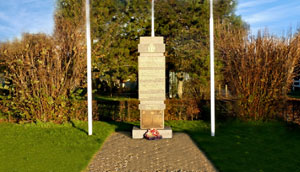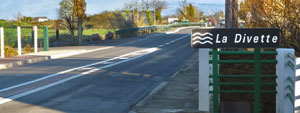Bavent
Varaville

6th Airborne Monument.
6th Airborne Monument and the Bridge
C Coy (Major HM Macleod) was to secure the DZ, destroy the enemy headquarters (HQ), secure the SE corner of the DZ, destroy the radio station at Varaville, and blow the bridge over the Divette stream in Varaville. C Coy would then join the battalion at the Le Mesnil cross roads.
A Coy (Major D Wilkins) would protect the left flank of 9th Battalion during their attack on the Merville Battery and then cover 9th Battalion's advance to the Leplein feature. They would seize and hold the Le Mesnil cross roads.

B Coy (Major C Fuller) was to destroy the bridge over the River Dives within two hours of landing and deny the area to the enemy until ordered to withdraw to Le Mesnil cross roads.
It should be noted that each paratrooper carried almost 50% more than the acceptable load tables for the invasion aircraft. Most of this additional load was extra ammunition. 1 Can Para assembled and boarded their aircraft in the evening hours of 5 June 1944. C Company departed at 2230 hours as part of the Pathfinder Group for the British 6th Airborne Division main force. The D-Day invasion had begun. The battle for the DZ and surrounding areas was tough and sometimes quite intense, but it was later determined that the German Army did not recognize that paratroops had been utilized until it was to late.
By mid-day, 06 June 1944, 1 Canadian Parachute Battalion had completed all tasks and seized their objectives. From this time until 06 September 1944, the Battalion was employed as an infantry unit on defensive and offensive operations. On the 6th September 1944, the Battalion returned to England (Carter Barracks) to rest, reorganize, be brought up to strength, and prepare for their next mission.